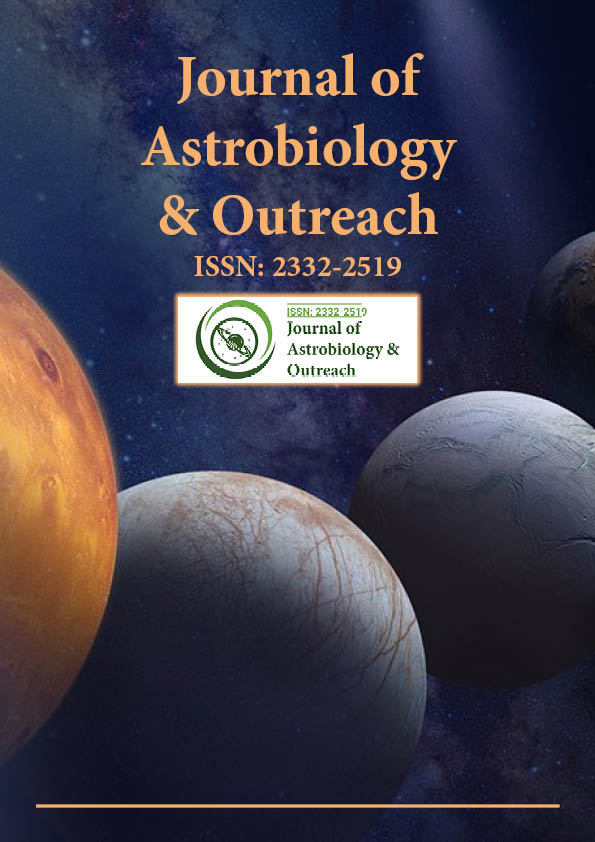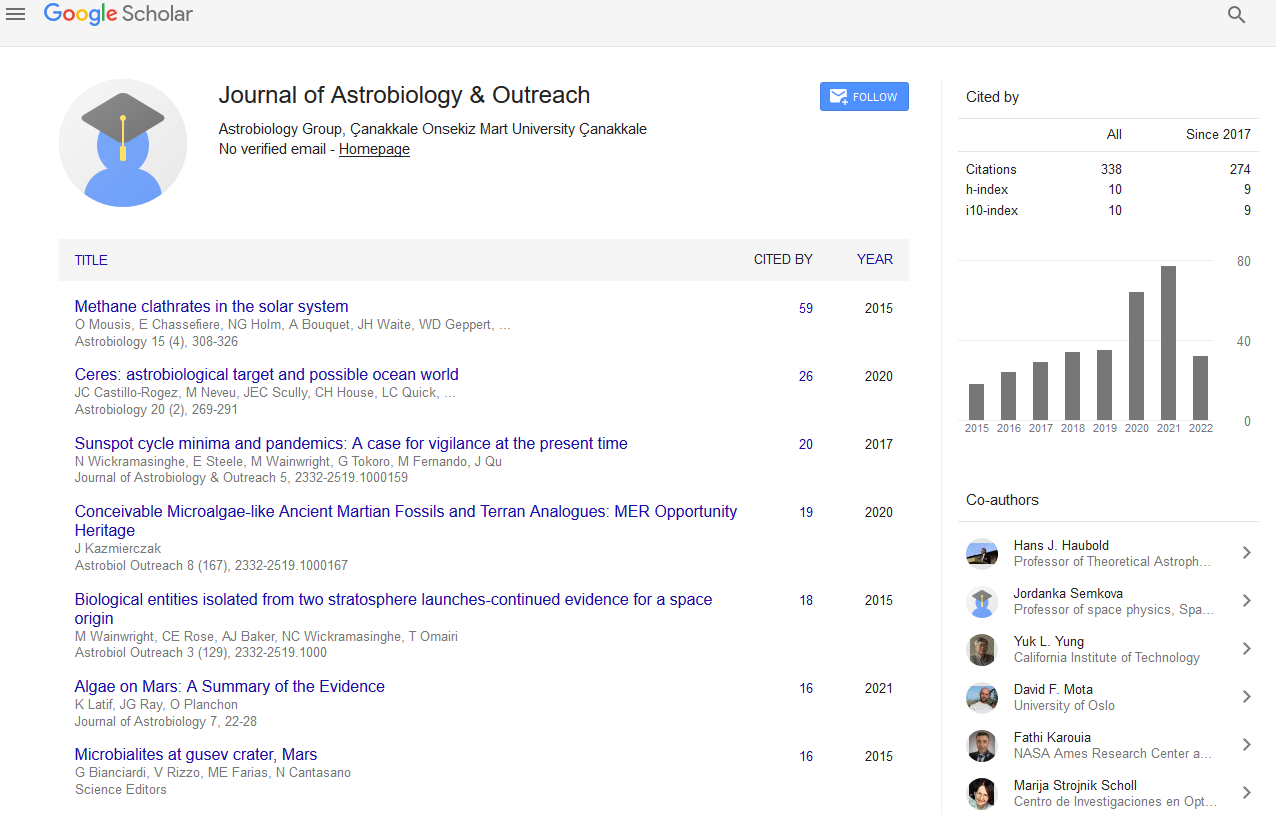Indexed In
- Open J Gate
- Academic Keys
- JournalTOCs
- RefSeek
- Hamdard University
- EBSCO A-Z
- OCLC- WorldCat
- Google Scholar
Useful Links
Share This Page
Journal Flyer

Open Access Journals
- Agri and Aquaculture
- Biochemistry
- Bioinformatics & Systems Biology
- Business & Management
- Chemistry
- Clinical Sciences
- Engineering
- Food & Nutrition
- General Science
- Genetics & Molecular Biology
- Immunology & Microbiology
- Medical Sciences
- Neuroscience & Psychology
- Nursing & Health Care
- Pharmaceutical Sciences
Opinion Article - (2025) Volume 13, Issue 1
Understanding Venusian Cloud Chemistry and Astrobiology
Fiona Andromeda*Received: 19-Feb-2025, Manuscript No. JAO-25-28775; Editor assigned: 21-Feb-2025, Pre QC No. JAO-25-28775 (PQ); Reviewed: 07-Mar-2025, QC No. JAO-25-28775; Revised: 14-Mar-2025, Manuscript No. JAO-25-28775 (R); Published: 21-Mar-2025, DOI: 10.35248/2332-2519.25.13.376
Description
The possibility of life in the clouds of Venus has experienced a dramatic revival due to the detection of intriguing chemical anomalies and the ongoing reevaluation of its atmospheric properties. Historically considered inhospitable due to its surface conditions, Venus has not featured prominently in the search for extraterrestrial life. However, the discovery of certain atmospheric signatures most notably, the debated presence of phosphine has opened a fresh dialogue about the planet’s astrobiological potential. The exploration of this possibility is both controversial and essential, given the implications such a finding would have on our understanding of life’s resilience and distribution in the universe.
The clouds of Venus situated between 48 to 60 kilometers above the surface, present a unique environment. Unlike the scorching surface that reaches nearly 470°C, the cloud layers possess temperate conditions with pressures and temperatures somewhat comparable to Earth’s lower atmosphere. This so-called "habitable zone" of Venus is acidic, dominated by concentrated sulfuric acid aerosols, but not beyond consideration for microbial extremophiles especially those known to survive in highly acidic, oxidizing environments on Earth. The central question remains: are these chemical signatures, such as the proposed phosphine, products of unknown geochemical processes, or do they hint at biological activity?
Phosphine (PH3) is considered a potential biosignature because on Earth it is primarily produced by anaerobic biological processes, with negligible abiotic pathways in oxidative environments. The reported detection of phosphine in the Venusian atmosphere though challenged and subject to reevaluation sparked intense debate because no known abiotic process can account for its presence in the observed quantities under Venusian conditions. Alternative explanations, such as volcanism, lightning, or photochemical processes, have been explored but fall short in fully accounting for the spectral data. While the phosphine detection remains contentious, the episode emphasized the limits of our current understanding of atmospheric chemistry and encouraged more focused exploration of Venus.
Beyond phosphine, other unexplained atmospheric phenomena strengthen the argument for taking Venus’s astrobiological potential seriously. These include the presence of unknown UV-absorbing particles in the cloud tops, non-equilibrium concentrations of gases like SO2, CO and H2S and dynamic cloud motions that defy simple meteorological modeling. These anomalies suggest the presence of active processes that are not entirely understood. Some researchers have proposed that the unknown UV absorbers could be complex organic molecules or even microbial life adapted to UV-shielding, energy-harvesting roles.
Skepticism surrounding biological interpretations is both valid and necessary. The extremely acidic nature of Venus’s clouds, with pH levels potentially below 0, challenges our Earth-centric notions of habitability. No known terrestrial life form can grow in such concentrations of sulfuric acid, although some acidophiles demonstrate remarkable tolerance. Nevertheless, the hypothesis that unknown biochemistries perhaps using alternative solvents or protective biofilms could evolve in such environments remains speculative but within the search of scientific plausibility. It pushes the boundaries of our definition of habitability and underscores the need for agnostic approaches in life detection.
The broader astrobiological community stands at a crossroads. While Mars and icy moons like Europa and Enceladus remain prime targets for life detection, the case for Venus challenges the notion that surface habitability is a prerequisite for life. If evidence of microbial life, past or present, is eventually found in the Venusian atmosphere, it would have profound implications. It would suggest that life is not only strong but capable of emerging or persisting in environments once deemed too hostile. It would also provide a cautionary lesson about prematurely ruling out environments based on incomplete models or Earth-biased expectations.
In conclusion, the astrobiological potential of Venus’s atmosphere, despite its harsh conditions, deserves serious and sustained scientific attention. The chemical anomalies observed in its clouds especially when considered collectively suggest active, poorly understood processes that merit direct investigation. Whether these signatures ultimately stem from unknown chemistry or biology, the journey to uncover their origins will refine our understanding of planetary atmospheres and habitability. Dismissing Venus as a candidate for life would be premature and embracing the challenge may yield one of the most profound discoveries in human history.
Citation: Andromeda F (2025). Understanding Venusian Cloud Chemistry and Astrobiology. J Astrobiol Outreach. 13:376.
Copyright: © 2025 Andromeda F. This is an open-access article distributed under the terms of the Creative Commons Attribution License, which permits unrestricted use, distribution, and reproduction in any medium, provided the original author and source are credited.

